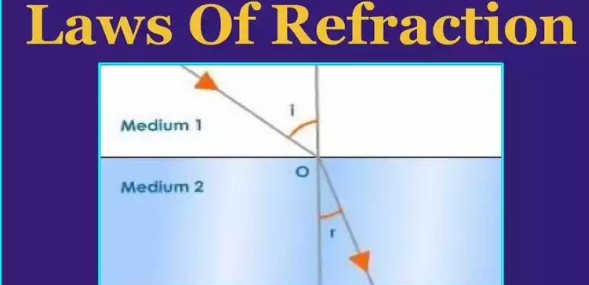 |
| Law of refraction and lens : Chapter light Class X science notes |
INTRODUCTION
When light ray travels in a homogeneous medium, it follows a straight line path. But as light ray passes obliquely from one transparent medium to another, it deviates from its original path. This phenomenon is called refraction of light. The deviation of light "occurs because light travels at different speeds in different media. The medium in which the speed of light is less is called denser medium while the medium in which the speed of light is more is called rarer medium . When light goes from one medium to another, the frequency of light does not change However, the velocity and wavelength of light change.
In this chapter, we shall deal with various aspects of refraction of light.
REFRACTION OF LIGHT
The 'phenomenon of change in the path of light ray as it passes obliquely from one transparent medium to another is called refraction of light.
§ When a ray of light goes from a rarer medium to a denser medium, it bends towards the normal .
§ When a ray of light goes from a denser medium to a rarer medium, it bends away from the normal .
§ No refraction takes place if the ray enters from one medium to another normally .
During refraction some changes occurs :
(i) When a light ray goes from one medium to another, the frequency of ray does not change.
(ii) The speed of light ray and wavelength of ray change.
(iii) The intensity of the refracted ray is less than that of the incident ray. It is because there is partial reflection and absorption of light at the surface.
LAWS OF REFRACTION:
The phenomenon of refraction of light ray takes place according to the following two laws:
1. The incident ray, the normal at the point of incidence and the refracted ray all lie in the same plane.
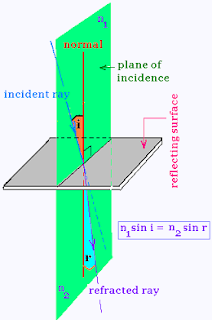 |
| First law of refraction |
2. The ratio of the sine of angle of incidence to the sine of angle of refraction is constant for the two medium.
Second law is known as Snell's law and holds good for all angles of incidence.
 |
| i.e Angle of incidence and angle of refraction may be vary but their ratio is always constant |
 |
| Where ' n ' is constant and called Refractive index of second medium w.r.t first medium. |
Note :
- The medium having incident ray is called first medium .
- The medium having refracted ray is called second medium.
LENSES:
A lens is a portion of a transparent medium (such as glass) bounded by two spherical surfaces .
Lenses are two types :
(1) Convex lens or converging lens
(2) Concave lens or diverging lens
1. Convex lens or converging lens.
A convex lens is thicker in the middle than at the edges. It converges (i.e. brings together) parallel rays of light on refraction through it.
A convex lens is thicker in the middle than at the edges. It converges (i.e. brings together) parallel rays of light on refraction through it.
Convex lenses are of three types.
(i) Double convex lens: Both surfaces are convex
(ii) Planoconvex lens - One surface convex 'and other plane
(iii) Concavoconvex lens : One surface is convex and the other concave
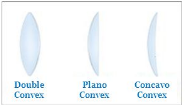 |
| Types of convex lens |
(ii) Planoconvex lens - One surface convex 'and other plane
(iii) Concavoconvex lens : One surface is convex and the other concave
 |
| converge parallel rays of light |
2: Concave lens or diverging lens.
A concave lens is thinner at the centre than at the edges.
It diverges (i.e. spreads out) parallel rays of light on refraction through it.
Concave lenses are of three types
(ii) Plano concave lens - One surface concave 'and other plane
(iii) Concavoconvex lens : One surface is convex and the other concave
(i) Centre of curvature (C).
The centre of curvature of the surface of a lens is the centre the sphere of which it forms a part. As a lens has two surfaces, therefore, it has two centres curvature (C1, C2)
(ii) Radius of curvature (R).
The radius of curvature of the surface of a lens is the radii of the sphere of which it forms a part .
(iii) Principal axis (C1,C2)
It is the straight line passing through the centers of curvature of the two surfaces of the lens.
(iv) Optical centre (C).
If the lens is thin and the radii of curvature of the two surfaces are equal, then geometric centre of the lens is the optical centre (C) of the lens.
In case of thick lens:
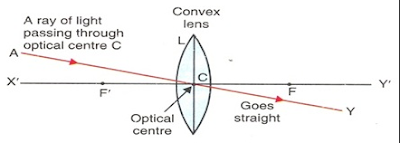 |
| A ray of light passing through the optical centre C of a thin lens goes straight without any deviation. |
If a ray of light is incident on a lens Such that after refraction through the lens, the emergent ray is parallel to the incident ray, then the point at which the refracted ray intersects the principal axis is called the optical centre of the lens.
It divides the thickness of the 'lens in the ratio of radii of curvature of the two surfaces of the lens.
IMPORTANT RAY PATHS FOR THIN LENS:
there are three rays that are particularly useful in locating the corresponding image point.
(i) When a ray is incident parallel to the principal axis of lens then refracted ray line passes through the principal focus F2.
(ii) The incident ray line passing through first focus becomes parallel to the principal axis after refraction.
(iii) The incident ray line passing through the optical center C is refracted along its original path .
Image formation:
When object is at infinity ( long distance from lens):
Object beyond the center of curvature (2F1 ) C1
Object at centre of curvature C1
Object between centre of curvature C1 and First focus F1
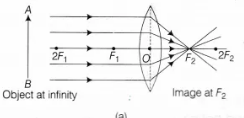 |
Nature of image At principal focus, Point image, real and inverted |
 |
Nature of image Between principal focus F2 and C2 , Diminished , Real , inverted |
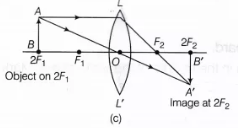 |
Nature of image At C2 , Equal , Real , inverted |
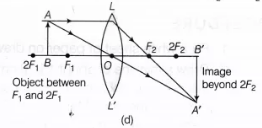 |
Nature of image Beyond C2 , Enlarged, Real, , inverted |
Object at focus F1
Object between first focus F1 and optical centre C
For concave lens:
 |
Nature of image At infinity , Highly enlarged , real , inverted |
 |
Nature of image Between first focus and C1 , Enlarged, virtual , erect |
When object is at infinity ( long distance from lens):
Object is at finite distance from lens
NEW CARTESIAN SIGN CONVENTION
 |
Nature of image At principal focus F , Point image, virtual and erect |
 |
Nature of image Diminished, virtual, erect and between optical center and first focus F1 . |
While dealing with refraction at lens , the following sign convention called New Cartesian Sign Convention is followed :
(i) All distances are measured from the optical center of the lens.
(ii) The distances measured in the direction of the incident light are taken as positive while those measured in the direction opposite to the incident light are taken as negative.
(iii) Heights or distances measured upward and perpendicular to the principal axis are considered positive while those measured downwards are considered negative.
According to this sign convention, the focal length (f) is positive for a convex lens and negative for a concave lens.
LINEAR MAGNIFICATION
The image formed by a lens may be larger than the object or smaller than the object or of the same size. The ratio of size (hi) of the image and size (ho) of the object is called linear magnification (m) of the lens.
The linear magnification is a number that simply tells how much taller the image is than the object.
other form of linear magnification
other form of linear magnification
 |
POWER OF A LENS :
power of a lens is its ability to deviate ray of light falling on it . it is reciprocal of its focal length.
power of a lens is its ability to deviate ray of light falling on it . it is reciprocal of its focal length.
COMBINATION OF THIN LENSES
In various optical instruments, two or more lenses are used either in contact or with a gap between them. Two or more lenses are combined to :
(i) increase the magnification of the image.
(ii) increase the sharpness of the final image by reducing the defects of images formed by a single lens.
(iii) make the image erect w.r.t the object.
(iv) increase the field of view.
The final image produced by the combination of thin lenses is found in the following manner. First, we find the image of the object formed by the first lens using lens formula. The image of the first lens is treated as the object for the second lens. The image of the second lens is again found by applying lens formula. This procedure is continued if the system has more lenses.
EQUIVALENT FOCAL LENGTH OF TWO THIN LENSES IN CONTACT
 |
| this formula is hold good for combination of convex as well as concave lens. |
 |
| this formula is hold good for combination of convex as well as concave lens. |
Refractive index:
When a ray of light goes from one medium to other medium , then some changes occurs during refraction Such as speed of light , wavelength , angle between ray and normal.
The capability of changing these physical quantity by refracting medium is measured in a physical term which is called refractive index.
Refractive index of refracting medium is denoted by
Where, n1 = absolute refractive index of incident medium
n2 = aboslute refractive index of refracting medium
1n2 = refractive index of refracting medium w.r.t incident medium
The ratio of speed of light in incident medium to that of refracting medium is called refractive index of refracting medium.
The ratio of wavelength of light in incident medium to that of refracting medium is called refractive index of refracting medium.
The ratio of wavelength of light in incident medium to that of refracting medium is called refractive index of refracting medium.
The ratio of sine of angle between ray and normal in incident medium to that of refracting medium is called refractive index of refracting medium.
(i) Convex lenses are used in spectacles to correct the defect of vision called hypermetropia (or long- sightedness).
(ii) Convex lens is used for making a simple camera.
(iii) Convex lens is used as a magnifying glass (or magnifying lens) (by palmists, watchmakers, etc.).
(iv) Convex lenses are used in making microscopes, telescopes and slide projectors (or film projectors).
Uses of Concave Lenses
(i) Concave lenses are used in spectacles to correct the defect of vision called myopia (or short- sightedness).
(ii) Concave lens is used as eye-lens in Galilean telescope.
(iii) Concave lenses are used in combination with convex lenses to make high quality lens systems for optical instruments.
(iv) Concave lens is used in wide-angle spy hole in doors.
Related Article ( Click to read )



















No comments:
Post a Comment